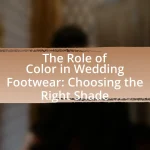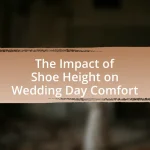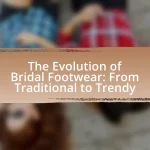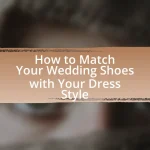The article examines the evolution of bridal gown styles throughout history, highlighting key characteristics that reflect cultural, social, and fashion trends from the 19th century to the present day. It details significant shifts in design, such as the introduction of the white wedding dress by Queen Victoria, the influence of the flapper movement in the 1920s, and the impact of World War II on gown simplicity. The article also explores how societal changes, including the feminist movement, have shaped bridal fashion, leading to contemporary trends that prioritize sustainability and individual expression. Key styles, materials, and silhouettes from each decade are analyzed, providing a comprehensive overview of how bridal attire has transformed over time.
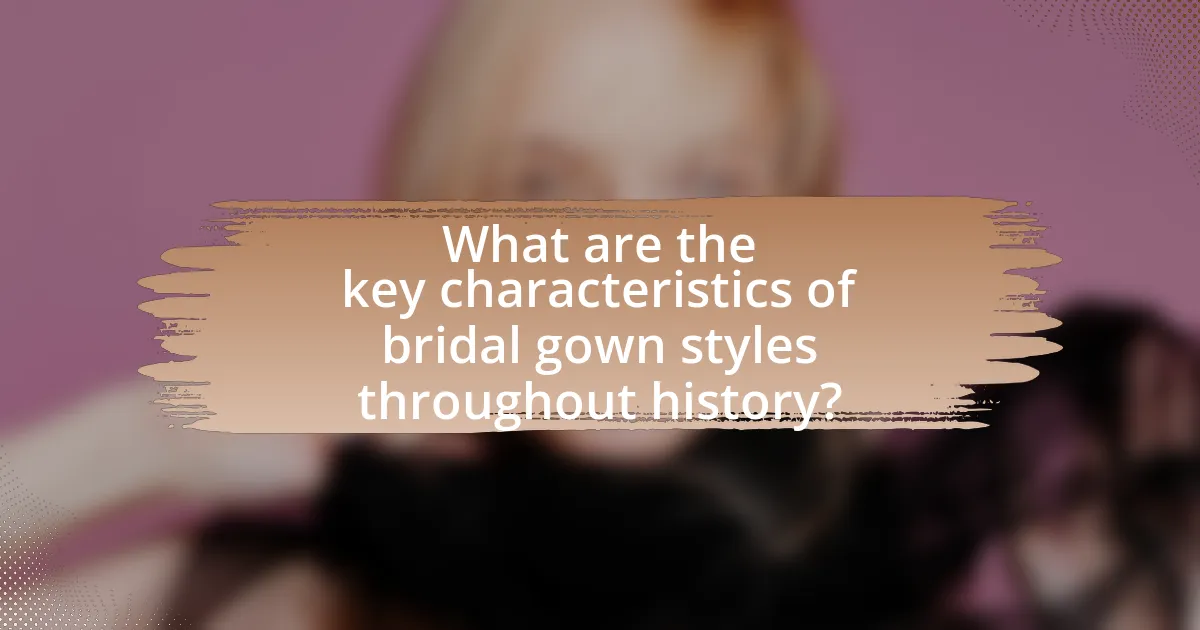
What are the key characteristics of bridal gown styles throughout history?
Bridal gown styles throughout history are characterized by their reflection of cultural, social, and fashion trends of their respective eras. In the 19th century, for example, the introduction of the white wedding dress by Queen Victoria in 1840 marked a shift towards romantic and modest designs, often featuring lace and long trains. The early 20th century saw the rise of simpler silhouettes, influenced by the flapper movement, which favored shorter hemlines and less ornate detailing.
During the mid-20th century, designers like Christian Dior popularized the hourglass silhouette, emphasizing femininity with fitted bodices and voluminous skirts. The late 20th century embraced a variety of styles, from bohemian to minimalist, reflecting the diverse cultural movements of the time. In recent years, bridal gowns have incorporated modern elements such as sustainable fabrics and innovative designs, showcasing a blend of tradition and contemporary aesthetics.
These characteristics illustrate how bridal gown styles have evolved, influenced by historical events, societal changes, and advancements in fashion design.
How did bridal gown styles evolve in the early 20th century?
Bridal gown styles evolved significantly in the early 20th century, transitioning from the elaborate, Victorian-inspired designs of the late 19th century to simpler, more modern silhouettes. In the 1900s, gowns featured high necklines and long sleeves, often made from luxurious fabrics like silk and lace, reflecting the Edwardian era’s emphasis on opulence. By the 1920s, the introduction of the flapper style brought shorter hemlines and a more relaxed fit, with brides opting for less formal, more practical dresses that allowed for greater movement. This shift was influenced by changing social norms and the rise of women’s rights, as brides began to prioritize comfort and personal expression over traditional constraints. The 1930s saw a return to elegance with bias-cut gowns that accentuated the figure, showcasing the influence of Hollywood glamour. These changes illustrate a broader cultural evolution, where bridal fashion mirrored societal shifts towards modernity and individuality.
What were the defining features of bridal gowns in the 1900s?
Bridal gowns in the 1900s were characterized by their elaborate designs, use of luxurious fabrics, and a shift towards white as the predominant color. The introduction of the white wedding dress was popularized by Queen Victoria in 1840, leading to a trend that persisted throughout the early 20th century. Gowns featured high necklines, long sleeves, and intricate lace detailing, often accompanied by long trains and veils. The silhouette was typically structured, with corsets emphasizing the waist and flowing skirts that gradually evolved into the more relaxed styles of the 1920s. These features reflected the societal norms and fashion sensibilities of the time, marking a significant evolution in bridal attire.
How did societal changes influence bridal gown designs in the 1910s?
Societal changes in the 1910s significantly influenced bridal gown designs by shifting preferences towards simpler, more practical styles that reflected the era’s evolving social norms. The onset of World War I led to a focus on functionality and modesty, as many women entered the workforce and sought dresses that allowed for ease of movement. This resulted in the decline of the elaborate, voluminous gowns of previous decades, with designers incorporating lighter fabrics and less ornate embellishments. Additionally, the suffragette movement promoted a sense of independence among women, which was mirrored in bridal fashion through the adoption of shorter hemlines and more streamlined silhouettes, emphasizing a modern, liberated identity.
What trends emerged in bridal gown styles during the 1920s and 1930s?
Bridal gown styles during the 1920s and 1930s saw significant trends characterized by a shift towards more relaxed silhouettes and the incorporation of modern fabrics. In the 1920s, the flapper style influenced bridal gowns, leading to shorter hemlines, dropped waistlines, and a more streamlined appearance, often featuring intricate beadwork and lace. By the 1930s, bridal gowns began to reflect Hollywood glamour, with longer, flowing lines, fitted bodices, and the use of luxurious materials like silk and satin, emphasizing elegance and sophistication. This evolution was marked by designers such as Vera Wang and the popularity of films that showcased glamorous wedding scenes, which further influenced bridal fashion trends.
How did the flapper movement impact bridal fashion in the 1920s?
The flapper movement significantly influenced bridal fashion in the 1920s by promoting a shift towards more relaxed and modern styles. This cultural change led to the adoption of simpler silhouettes, such as the drop-waist gown, which reflected the flapper’s rejection of traditional constraints. Additionally, bridal dresses began to incorporate elements like shorter hemlines and lighter fabrics, aligning with the flapper’s emphasis on freedom and comfort. The popularity of the flapper style also encouraged brides to choose less formal attire, moving away from the heavily structured gowns of previous decades. This transformation in bridal fashion was evident in the designs of prominent fashion houses, which embraced the flapper aesthetic, thus marking a significant departure from Victorian and Edwardian styles.
What were the popular materials and silhouettes in the 1930s bridal gowns?
In the 1930s, popular materials for bridal gowns included silk, satin, and lace, while the silhouettes were characterized by a more streamlined, elegant fit with a focus on the natural waistline and flowing skirts. The use of luxurious fabrics like silk and satin contributed to the glamorous aesthetic of the era, while lace details added a romantic touch. Silhouettes often featured bias-cut designs that enhanced the body’s curves, reflecting the fashion trends of the time, which emphasized femininity and sophistication.
How did World War II affect bridal gown styles in the 1940s?
World War II significantly influenced bridal gown styles in the 1940s by promoting simpler, more practical designs due to fabric rationing and wartime austerity. As materials like silk and lace became scarce, brides opted for gowns made from less expensive fabrics, often featuring minimal embellishments and streamlined silhouettes. This shift reflected the broader societal changes during the war, where practicality took precedence over extravagance. The wartime context led to the popularity of tea-length dresses and the use of alternative materials, such as rayon and cotton, which were more readily available.
What were the common themes in bridal fashion during wartime?
Common themes in bridal fashion during wartime included simplicity, practicality, and resourcefulness. During periods such as World War I and World War II, brides often opted for less elaborate designs due to fabric shortages and the need for rationing. For instance, the use of shorter hemlines and simpler silhouettes became prevalent, reflecting both the economic constraints and a shift towards more functional attire. Additionally, many brides incorporated materials that were readily available, such as cotton or repurposed fabrics, further emphasizing the theme of resourcefulness. Historical records indicate that these trends were not only a response to wartime conditions but also influenced post-war fashion, as the desire for simplicity persisted even after the conflicts ended.
How did post-war optimism shape bridal gown designs in the late 1940s?
Post-war optimism significantly influenced bridal gown designs in the late 1940s by promoting a return to traditional femininity and elegance. This period saw an increase in the use of luxurious fabrics, intricate detailing, and fuller silhouettes, reflecting a societal desire for celebration and normalcy after the hardships of World War II. Designers like Christian Dior introduced styles that emphasized a cinched waist and voluminous skirts, which became iconic in bridal fashion. The emphasis on romantic and elaborate designs was a direct response to the optimism of the era, as couples sought to express joy and hope through their weddings.
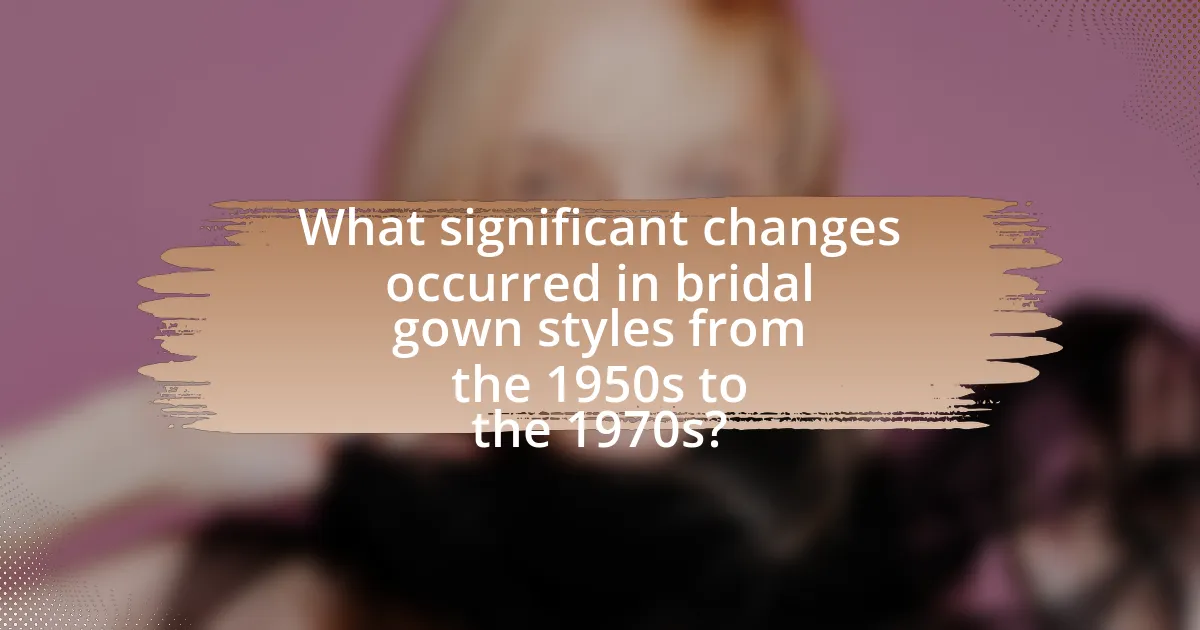
What significant changes occurred in bridal gown styles from the 1950s to the 1970s?
Bridal gown styles underwent significant transformations from the 1950s to the 1970s, shifting from structured, voluminous designs to more relaxed, free-flowing silhouettes. In the 1950s, gowns typically featured full skirts, cinched waists, and intricate embellishments, reflecting the post-war desire for femininity and traditionalism. By the 1970s, influenced by the counterculture movement, bridal gowns embraced bohemian aesthetics, with styles incorporating flowing fabrics, bell sleeves, and less rigid structures, often favoring simplicity and comfort over opulence. This evolution mirrored broader societal changes, including shifts in women’s roles and fashion sensibilities during that period.
How did the 1950s define the modern bridal gown silhouette?
The 1950s defined the modern bridal gown silhouette by popularizing the full-skirted, hourglass shape that emphasized femininity and elegance. This silhouette was characterized by fitted bodices and voluminous skirts, often supported by crinolines or petticoats, which created a dramatic and romantic appearance. The influence of designers like Christian Dior, particularly his “New Look” introduced in 1947, played a crucial role in shaping bridal fashion during this decade, as it celebrated a return to traditional femininity after the austerity of World War II. The prevalence of this silhouette in bridal fashion established a lasting standard that continues to influence modern bridal gown designs.
What role did iconic figures play in popularizing 1950s bridal styles?
Iconic figures played a crucial role in popularizing 1950s bridal styles by setting trends that influenced public perception and fashion choices. Celebrities such as Grace Kelly and Audrey Hepburn showcased elegant bridal gowns that embodied the era’s romantic aesthetic, leading to increased demand for similar styles among brides. Grace Kelly’s wedding to Prince Rainier of Monaco in 1956 featured a gown designed by Helen Rose, which became an iconic representation of bridal fashion and inspired countless replicas. Similarly, Audrey Hepburn’s portrayal of a bride in “Funny Face” (1957) highlighted the allure of sophisticated, modern designs, further cementing the influence of these figures on bridal trends. Their visibility in media and high-profile events made their styles aspirational, significantly shaping the bridal fashion landscape of the 1950s.
How did fabric choices evolve during the 1950s?
Fabric choices during the 1950s evolved significantly, transitioning from traditional materials to more innovative options. The decade saw an increased use of synthetic fabrics like nylon and polyester, which offered durability and ease of care compared to natural fibers such as silk and cotton. This shift was influenced by advancements in textile technology and a growing consumer preference for modern, low-maintenance garments. Additionally, the popularity of structured silhouettes in bridal gowns led to the incorporation of fabrics like taffeta and organza, which provided the necessary volume and shape. The combination of these factors marked a notable change in bridal fashion, reflecting broader societal trends towards modernization and practicality.
What were the key bridal fashion trends of the 1960s?
The key bridal fashion trends of the 1960s included A-line silhouettes, mini and tea-length dresses, and the use of bold colors and patterns. A-line gowns became popular for their flattering shape, while shorter hemlines reflected the era’s youthful spirit and the influence of designers like Mary Quant. Additionally, brides began to incorporate non-traditional colors such as pink and blue, moving away from the classic white gown, which was a significant shift in bridal fashion norms during this decade.
How did cultural movements influence bridal gown designs in the 1960s?
Cultural movements significantly influenced bridal gown designs in the 1960s by promoting more relaxed and unconventional styles that reflected the era’s social changes. The feminist movement encouraged women to embrace individuality, leading to the popularity of shorter hemlines and non-traditional silhouettes, such as A-line and empire waist gowns. Additionally, the counterculture movement inspired the use of bohemian elements, including lace, floral patterns, and less formal fabrics, which contrasted sharply with the more traditional and formal bridal attire of previous decades. This shift was evident in the designs of notable fashion houses and designers, such as Mary Quant and Yves Saint Laurent, who incorporated these cultural influences into their bridal collections, marking a departure from the classic, conservative styles of the past.
What styles became popular in the late 1960s and early 1970s?
In the late 1960s and early 1970s, bohemian and vintage-inspired styles became popular in bridal fashion. This period saw the rise of flowing silhouettes, often featuring long sleeves, lace, and floral patterns, reflecting the counterculture movement of the time. The iconic wedding dress worn by Bianca Jagger in 1971, which was a simple yet elegant design, exemplified this trend. Additionally, the influence of the hippie movement led to the popularity of more relaxed and informal wedding attire, moving away from the traditional structured gowns of previous decades.
What impact did the feminist movement have on bridal fashion in the 1970s?
The feminist movement significantly transformed bridal fashion in the 1970s by promoting individualism and challenging traditional gender roles. This era saw a shift from conventional, formal wedding gowns to more relaxed and diverse styles that reflected women’s growing autonomy. Designers began to incorporate elements such as shorter hemlines, non-white colors, and bohemian influences, allowing brides to express their personal identities rather than conforming to societal expectations. The rise of the feminist movement also encouraged the rejection of the notion that marriage was the ultimate goal for women, leading to a broader acceptance of alternative wedding formats and attire that emphasized personal choice over tradition.
How did bridal gown designs reflect changing attitudes towards marriage?
Bridal gown designs have reflected changing attitudes towards marriage by evolving in style, fabric, and symbolism, mirroring societal shifts in gender roles, personal choice, and the institution of marriage itself. For instance, the transition from the traditional, heavily embellished gowns of the Victorian era, which emphasized family and social status, to the simpler, more personal styles of the 1920s and 1960s, indicates a move towards individual expression and romantic love over economic or social considerations. The rise of the modern wedding dress in the late 20th century, characterized by diverse styles and colors, further illustrates a shift towards personal preference and equality in marriage, as seen in the increasing popularity of non-white gowns and less formal attire. This evolution in bridal gown design serves as a tangible reflection of the changing perceptions of marriage from a transactional arrangement to a partnership based on love and personal choice.
What were the most notable styles of the 1970s bridal gowns?
The most notable styles of the 1970s bridal gowns included flowing A-line silhouettes, bohemian-inspired designs, and the use of soft, lightweight fabrics like chiffon and lace. A-line gowns, characterized by their fitted bodices and flared skirts, became popular for their flattering shape. Bohemian styles featured elements such as bell sleeves, floral patterns, and relaxed fits, reflecting the counterculture movement of the era. Additionally, many gowns incorporated vintage elements, such as high necklines and long sleeves, often inspired by the fashion of previous decades. These styles were emblematic of the 1970s’ emphasis on individuality and comfort in bridal fashion.

How have bridal gown styles transformed from the 1980s to the present day?
Bridal gown styles have transformed significantly from the 1980s to the present day, shifting from extravagant, voluminous designs to more streamlined and minimalist silhouettes. In the 1980s, bridal gowns often featured large puffed sleeves, ruffles, and extensive embellishments, reflecting the opulence of the era, as seen in the iconic wedding dress of Princess Diana in 1981. In contrast, contemporary styles emphasize simplicity and elegance, with many modern gowns showcasing clean lines, subtle details, and a focus on fabric quality, such as silk and lace. This evolution mirrors broader fashion trends that prioritize individual expression and comfort, as evidenced by the rise of alternative bridal styles and the popularity of non-traditional colors and designs in recent years.
What were the defining features of bridal gowns in the 1980s?
Bridal gowns in the 1980s were characterized by dramatic silhouettes, voluminous skirts, and extravagant embellishments. The era saw the popularity of puffed sleeves, often accompanied by lace and satin fabrics, creating a romantic and opulent look. Additionally, many gowns featured long trains and intricate detailing, such as beading and embroidery, reflecting the decade’s penchant for excess and grandeur. The influence of pop culture, particularly from high-profile weddings like that of Princess Diana in 1981, further solidified these defining features in bridal fashion.
How did pop culture influence bridal fashion in the 1980s?
Pop culture significantly influenced bridal fashion in the 1980s by introducing bold styles and extravagant designs that reflected the era’s trends. Iconic films like “Wedding Crashers” and television shows such as “Dynasty” showcased opulent wedding scenes, inspiring brides to opt for dramatic silhouettes, puffed sleeves, and extensive embellishments. The popularity of celebrity weddings, particularly that of Princess Diana in 1981, further propelled the desire for lavish gowns, characterized by long trains and intricate lace details. This cultural shift led to a surge in bridal boutiques offering diverse styles that mirrored the glamour and excess of 1980s pop culture, ultimately shaping the aesthetic of bridal fashion during that decade.
What materials and embellishments were popular during this decade?
During this decade, popular materials for bridal gowns included lace, satin, and chiffon, while embellishments featured beading, embroidery, and appliqué. Lace became a favored choice due to its delicate and romantic appearance, often used in sleeves and overlays. Satin provided a luxurious sheen and smooth texture, making it ideal for structured gowns. Chiffon was appreciated for its lightweight and flowing qualities, perfect for ethereal designs. Beading and embroidery added intricate details, enhancing the visual appeal of gowns, while appliqué offered a three-dimensional effect, allowing for creative designs. These materials and embellishments reflected the trends and preferences of brides during this period, emphasizing elegance and personalization in bridal fashion.
How did the 1990s and early 2000s redefine bridal gown aesthetics?
The 1990s and early 2000s redefined bridal gown aesthetics by introducing a shift towards more relaxed, less formal designs, moving away from the traditional, structured silhouettes of previous decades. This era saw the rise of minimalist styles, characterized by clean lines and understated elegance, as exemplified by the popularity of sheath and A-line gowns. Additionally, the influence of pop culture, particularly through celebrities like Princess Diana and later, the television show “Friends,” popularized non-traditional elements such as color, shorter hemlines, and unique fabrics. The incorporation of these elements reflected a broader cultural shift towards individuality and personal expression in wedding attire, marking a significant departure from the conventional bridal aesthetic.
What minimalist trends emerged in bridal fashion during the 1990s?
Minimalist trends in bridal fashion during the 1990s included simple silhouettes, clean lines, and understated elegance. Designers like Vera Wang popularized gowns that featured minimal embellishments, focusing instead on the quality of fabric and tailoring. The decade saw a shift away from traditional, ornate designs towards more contemporary styles, emphasizing a less-is-more approach that resonated with modern brides seeking sophistication without excess. This trend was characterized by the use of fabrics such as silk and satin, often in solid colors, which further highlighted the minimalist aesthetic.
How did celebrity weddings shape bridal gown styles in the early 2000s?
Celebrity weddings in the early 2000s significantly influenced bridal gown styles by popularizing extravagant designs and unique silhouettes. High-profile weddings, such as those of Jennifer Lopez and Britney Spears, showcased elaborate gowns that set trends for brides seeking to emulate their favorite stars. The media coverage of these events amplified the visibility of specific styles, leading to increased demand for similar designs in bridal boutiques. For instance, the iconic Vera Wang gowns worn by celebrities became synonymous with luxury and elegance, prompting many brides to seek out similar aesthetics for their own weddings. This era marked a shift towards more personalized and statement-making bridal attire, reflecting the influence of celebrity culture on fashion choices.
What current trends are shaping bridal gown styles today?
Current trends shaping bridal gown styles today include a focus on sustainability, minimalist designs, and the incorporation of bold colors and patterns. Sustainability has become a priority, with many designers using eco-friendly materials and ethical production practices, reflecting a growing consumer demand for environmentally conscious fashion. Minimalist designs emphasize clean lines and simplicity, often featuring understated elegance that appeals to modern brides. Additionally, bold colors and patterns are gaining popularity, moving away from traditional white gowns to vibrant hues and unique prints, allowing brides to express their individuality. These trends are supported by market research indicating a shift in consumer preferences towards personalization and sustainability in the bridal industry.
How are sustainable practices influencing modern bridal fashion?
Sustainable practices are significantly influencing modern bridal fashion by promoting eco-friendly materials and ethical production methods. Designers are increasingly using organic fabrics, such as cotton and linen, and repurposing vintage garments to reduce waste. According to a 2021 report by the Ellen MacArthur Foundation, the fashion industry is responsible for 10% of global carbon emissions, prompting many bridal brands to adopt sustainable practices to mitigate their environmental impact. This shift not only caters to environmentally conscious consumers but also aligns with a growing trend towards transparency in the supply chain, where brands disclose their sourcing and manufacturing processes.
What are the most popular styles and silhouettes in contemporary bridal gowns?
The most popular styles and silhouettes in contemporary bridal gowns include A-line, ball gown, sheath, and mermaid. A-line gowns are characterized by a fitted bodice that gradually flares out, creating a flattering silhouette for various body types. Ball gowns feature a full skirt and a fitted bodice, often chosen for traditional weddings. Sheath gowns are form-fitting and follow the body’s natural shape, appealing to modern brides seeking a sleek look. Mermaid gowns are fitted through the bodice and hips, flaring out at the knees, which accentuates curves. These styles reflect current trends in bridal fashion, emphasizing both elegance and individuality.
What practical tips should brides consider when choosing a bridal gown?
Brides should consider their body shape, budget, and wedding theme when choosing a bridal gown. Understanding body shape helps in selecting a silhouette that flatters, such as A-line for pear shapes or mermaid for hourglass figures. Setting a budget is crucial, as bridal gowns can range from a few hundred to several thousand dollars, and knowing this helps narrow down options. Additionally, aligning the gown with the wedding theme—whether it’s vintage, modern, or bohemian—ensures a cohesive look. These practical tips are essential for making an informed and satisfying choice in bridal gown selection.
How can brides determine their ideal gown style based on body type?
Brides can determine their ideal gown style based on body type by understanding how different silhouettes complement their unique shapes. For example, A-line gowns flatter pear-shaped bodies by accentuating the waist while skimming over the hips, whereas ball gowns provide volume and support for those with an hourglass figure. Additionally, sheath dresses suit athletic body types by creating a streamlined look, while empire waist gowns can enhance a petite frame by elongating the torso. This guidance is supported by fashion experts who emphasize the importance of silhouette in achieving a balanced and flattering appearance for each body type.
What factors should brides consider regarding budget and customization?
Brides should consider the total cost of the wedding, including dress, alterations, and accessories, when budgeting for customization. Customization options can significantly increase expenses; for instance, bespoke gowns can range from $1,000 to over $10,000 depending on fabric and design complexity. Additionally, brides should evaluate the potential for resale value of customized gowns, as unique designs may retain or increase value over time. Understanding these financial implications helps brides make informed decisions that align with their overall wedding budget.

